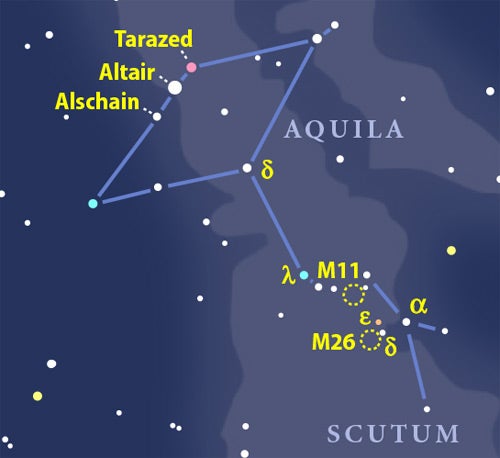If you are viewing under dark skies, then you might notice the hazy lane of our galaxy, the Milky Way, flowing past Altair. If light pollution interferes with your view, try to follow the Milky Way through your binoculars. Scan southeastward a little more than a field diameter to the 3rd-magnitude star Delta (δ) Aquilae, and then an equal distance farther southeastward, to 3rd-magnitude Lambda (λ) Aquilae. Lambda and two fainter, adjacent stars form an arc that hooks counterclockwise, directly toward the Scutum Star Cloud.
Calling it a “star cloud,” however, is incorrect. The Scutum Star Cloud is not a physical cloud of stars at all. Ironically, the “cloud” actually is a clearing in the interstellar dust that otherwise blocks our view into the Milky Way’s depths. The dust’s density doesn’t allow us to see through it with ordinary means. If you think of these clouds as curtains drawn over much of the Milky Way, Scutum functions as an open window. In fact, we probably should call it the Scutum Star Window.
Studying the Scutum area through binoculars shows a broad range of star colors and intensities. As you look around, notice several pockets where the star density increases. Some are just illusions, random gatherings of stars along our line of sight, while others make up bona fide groups.
M11, a dense open star cluster, stands out as a dazzling sight. You can find it as a bright smudge of starlight just to the west of the Eagle’s tail-feather stars. Because most of M11’s stars are too faint for binoculars, they blend into a small, round mist of starlight, except for a lone 8th-magnitude sun that shines above the fray.
Altogether, M11 holds more than 1,000 stars within its grip, all crammed within roughly 24 light-years of space. Although most are young, white suns, the cluster’s more massive stars — which evolve more rapidly — already have left the main sequence stage and entered their red-giant phase. Knowing this, astronomers estimate M11 is about 100 million years old.
A second smudge of condensed starlight is located about half a binocular field southwest of M11. Look for it just to the southwest of a slender right triangle of stars formed by Alpha (α), Delta, and Epsilon (ε) Scuti. Although this open cluster, cataloged as M26, is not nearly as bright and obvious as M11, it should still be visible through handheld binoculars fairly easily on clear, moonless nights.
M26 includes about 30 stars. None shines brighter than 10th magnitude and so is not bright enough to be seen through most binoculars. Instead, M26’s light produces a hazy glow covering about a quarter of a degree, or about half of the Moon’s diameter in our sky.
The Scutum Star Cloud … excuse me, Star Window, is a beautiful sight with deep-sky gems hidden within. Let your binoculars take you there tonight!
Next month, we will continue our tour of the Milky Way, moving northward from the Eagle to the Swan. Till then, remember, two eyes are better than one.











